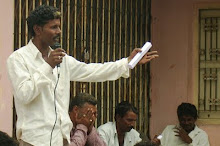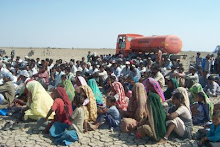Business Standard: Mumbai/ Ahmedabad: Saturday, February
23, 2013.
Around 45,000
salt pan workers, locally known as agariyas, who work in the Little Rann of
Kutch (LRK) have been left in the lurch, thanks to the process of survey and
settlement of rights for the proposed Wild Ass Sanctuary, which has
surprisingly not recognised these salt producers. The salt pan workers are
quite miffed with the fact that while the government lacks records of the
traditional work they do, the survey and settlement process demands the
commmunity to prove their existence through documentary evidences.
In order to
support the small salt producers, in 1948, the Government of India made special
provision for the agariyas, where they did not require any permit or license to
produce salt. "The Rann land belongs to the government of Gujarat and has
been administered simultaneously by district collectors of Surendranagar,
Rajkot, Mehsana, Banaskantha and Kutch. In spite of this, the land has never
been surveyed. Under the land revenue department, the LRK has only one survey
number—zero. This has resulted in no clarity as to the boundaries of the
districts. Thus, the land lease given for the salt making in the Rann has never
had any specific location or proper survey number as in other revenue
areas," Harinesh Pandya, trustee, Agariya Heet Rakshak Manch said at a press
conference today.
As per the
provision of section 19 of Wild Life Protection Act, 1972, the process of
settlement of rights in the 'notified' sanctuary area has to be completed and a
settlement report has to be prepared before the final declaration. Ironically,
the process was initiated 24 years after the notification and is still on. Even
as the process of 'survey and settlement of rights is going on since 1997, the
agariyas have been getting notices for illegal occupation and eviction since
November 2006.
As per the
report by settlement officer, 2398 claims of salt pan-workers were verified by
settlement officer of which 397 have have been approved. "In order for the
sanctuary to come into effect, the settlement process of claims and rights have
to be followed by a final notification by the Ministry of Environment or by the
state assembly. But there is no mention of the agariyas in the report. Besides,
many agariyas claim ignorance about receiving any notice for filing claims and
an analysis indicates that at some places, many claims were forged,"
Pandya added.
India is the
third largest salt producer in the world and salt pan workers of Little Rann of
Kutch produce about 30 per cent of country's total salt and fifty per cent of
Gujarat's total salt. There are about 12,000-15,000 families which work as salt
workers from 107 villages in LRK.
The season
for salt harvesting is from September to June when over 10,000 agariya families
wade three kilometers deep in the deserts in search of livelihood. A worker
earns about Rs 140 per tonne of salt.
The workers
are now fearing the treat of displacement and loss of livelihood, as they have
been receiving notices rejecting their claims, without even applying for any.
















.jpg)
.jpg)
.jpg)
.jpg)













1 comment:
Why has there been no mention about industries near surajbari creek..?
I guess that is a major threat for not just agariya but also the agatiya labourers who work alike agariya at very minimal rates...
Also I couldnt find a single news article on the same..
Post a Comment